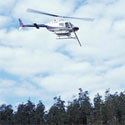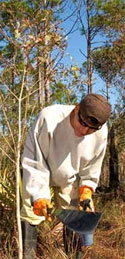Management
While many citizens of South Florida realize that melaleuca is a bad tree, few know how to kill it. Furthermore, land and property managers across the region may also have questions about how best to manage this noxious invader. For all these people, TAME Melaleuca is here to show you your options.
First, several preliminary questions should be answered before making any decision:
- What can you afford to spend per tree or per acre?
- What is the percentage of native species coverage and how much off-target damage can be tolerated?
- How about off-target damage to lawns or shrubs?
- Is soil compaction or rutting from heavy machinery an issue?
- How accessible is the site for machinery?
- Will you control resprouts or seedlings?
- How many trees do you have to kill?
- Can the dead trees (snags) be left standing?
- Do the stumps need to be ground?
To assist in answering these questions, people may want to visit one of our demonstration sites. At these sites, we hired the contractors to kill melaleuca trees using their own technology. As a result, interested people can view and compare the results, both the intended--dead melaleuca trees, and any unintended--rutted ground, seedling regrowth, damage to native plants, and so on. We also supply the cost/acre information.
Any discussion of melaleuca management should stress the concept of Integrated Pest Management (IPM). IPM integrates available control methods, and for melaleuca these are principally mechanical, chemical, and biological control agents. All three are needed to successfully control melaleuca, and any one method will not control trees. While herbicides will kill trees, they cannot keep up with seed production. Biological control agents decrease seed production and growth rates, but don't usually kill trees. Unless a stump is ground, trees will resprout after being cut down. Thus, a combination of all tactics is the only way we will ever win the war on melaleuca.
An IPM approach is also very comprehensive. In addition to removing standing trees, care is also taken to prevent reproduction and regeneration of trees. This includes reducing seed production and preventing seedlings from becoming established. Melaleuca trees produce seeds throughout their lifetime, and many of them (millions!) are retained in capsules on the branches. Tree death or stress causes the capsules to open and release their seeds. The cutting of a single tree can result in thousands of seedlings the following year.



